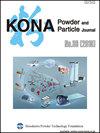Particle Preparation and Morphology Control with Mutual Diffusion Across Liquid-Liquid Interfaces
IF 3.2
4区 材料科学
Q3 ENGINEERING, CHEMICAL
引用次数: 2
Abstract
Advanced functional materials require sophisticated control of particle characteristics. The bottom-up process has been extensively used to produce functional materials for controlling the particle properties of composite particles. We propose crystallization at liquid-liquid interfaces as an advanced particle formation method. This review introduces crystallization at a liquid-liquid interface based on several case studies used in various applications. Conventional crystallization has been generally used to produce crystals and particles with homogeneous particle properties. Liquid-liquid interfacial crystallization makes it possible to create composite particles with hetero-phase structures and interfaces. Liquid-liquid interfacial crystallization with an inkjet technique can control the droplet size accurately, and the shape and particle size distribution are successfully controlled in inorganic-organic composite particles. In addition, we succeed in creating organic-organic composite particles using the interfacial crystallization by an ultrasonic spray nozzle. The coating efficiency of organic particles on the particles is enhanced using the ultrasonic spray nozzle in comparison with anti-solvent crystallization. In this study, the fabrication of inorganic-organic composite particles using a coaxial tube reactor on the liquid-liquid interfacial crystallization is proven successful. These findings suggest that liquid-liquid interfacial crystallization is a promising means of efficiently producing composite particles because of their applicability to infusion in various processes.液-液界面相互扩散的粒子制备和形态控制
先进的功能材料需要对颗粒特性进行精密的控制。自底向上工艺已被广泛应用于控制复合颗粒颗粒性能的功能材料的生产。我们提出在液-液界面上结晶作为一种先进的粒子形成方法。这篇综述介绍了在液-液界面的结晶基于几个案例研究在各种应用。常规结晶通常用于生产具有均匀颗粒性质的晶体和颗粒。液-液界面结晶使制备具有异相结构和界面的复合粒子成为可能。采用喷墨技术进行液-液界面结晶可以精确地控制液滴的大小,成功地控制了无机-有机复合颗粒的形状和粒径分布。此外,我们还成功地利用超声波喷嘴的界面结晶制备了有机-有机复合颗粒。与反溶剂结晶相比,超声波喷嘴可提高有机颗粒在颗粒上的包覆效率。在本研究中,利用同轴管反应器在液-液界面结晶上成功制备了无机-有机复合颗粒。这些发现表明,液-液界面结晶是一种很有前途的高效生产复合颗粒的方法,因为它适用于各种工艺的灌注。
本文章由计算机程序翻译,如有差异,请以英文原文为准。
求助全文
约1分钟内获得全文
求助全文
来源期刊

KONA Powder and Particle Journal
工程技术-材料科学:综合
CiteScore
8.40
自引率
4.90%
发文量
35
审稿时长
>12 weeks
期刊介绍:
KONA publishes papers in the broad field of powder science and technology, ranging from fundamental principles to practical applications. Papers describing technological experience and critical reviews of existing knowledge in special areas are also welcome.
 求助内容:
求助内容: 应助结果提醒方式:
应助结果提醒方式:


